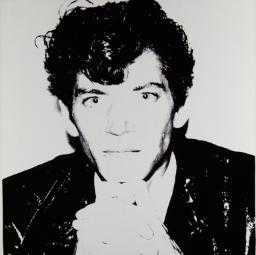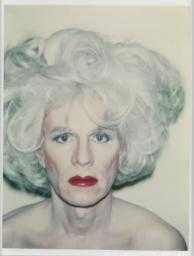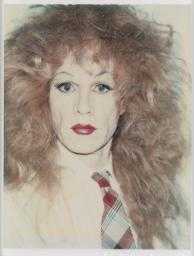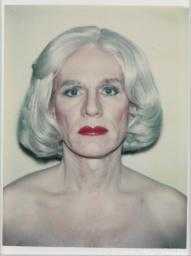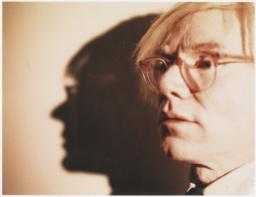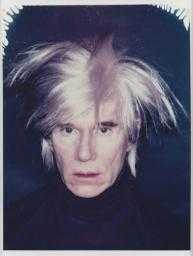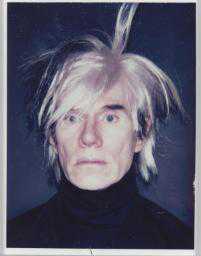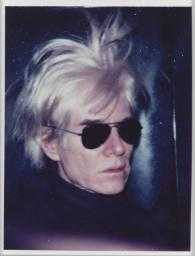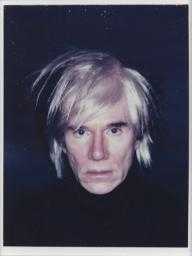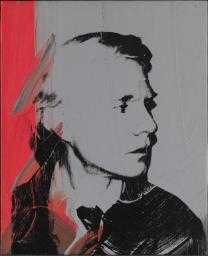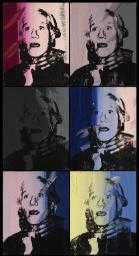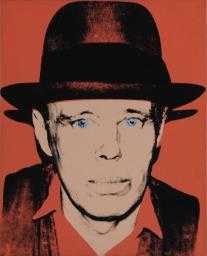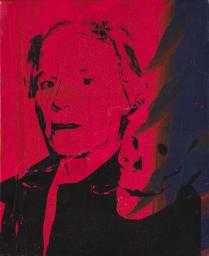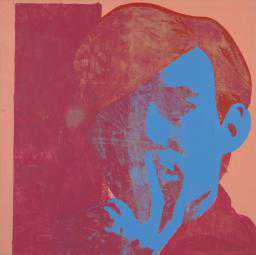
Not on display
- Artist
- Andy Warhol 1928–1987
- Medium
- Acrylic paint and screenprint on canvas
- Dimensions
- Support: 2032 × 2032 mm
- Collection
- Tate
- Acquisition
- Presented by Janet Wolfson de Botton 1996
- Reference
- T07146
Summary
Self-Portrait is an acrylic paint and screenprint work on canvas by the American artist Andy Warhol. It is a large portrait of Warhol and employs an arresting colour scheme in which the artist’s vivid red head floats against an empty black background. The artist’s neck, shoulders and torso have been excluded from the portrait, focussing the attention on his face, expression and hair. Warhol stares directly out at the viewer with an intense gaze, his lips slightly parted and his expression blank. The most animated part of the portrait is the artist’s hair, which sweeps strikingly across the canvas in a strong, diagonal movement from the top-left corner down towards the lower-right.
Warhol made Self-Portrait in his studio at 22 East 33rd Street in New York, to which he had moved in 1984 from his more famous studio, known as the Factory. Warhol used assistants to aid him in the production of his works, and from 1977 Rupert Smith was employed by Warhol for screenprinting and may therefore have helped to produce Self-Portrait (see Marco Livingstone in McShine 1989, p.63). The art dealer Tony Shafrazi has described how Warhol carefully constructed his screenprints by taking a number of photographs of his model (in this case himself), selecting an image that he liked, marking where it should be cropped and then sending the negative to a photographic laboratory for enlargement and transfer onto an acetate sheet. Shafrazi continues: ‘he would position the acetate onto a canvas where the final silkscreened head would go, using it as a guide to paint a rough approximation of the face and features in patches of colour. Once the silkscreen was produced from the acetate, Warhol and an assistant would squeegee ink through the screen onto a pre-painted canvas’ (Shafrazi 2007, p.14).
The art historian Marco Livingstone has commented on the importance of these working methods, which were typical of the artist’s practice in his later career. Livingstone has argued that ‘a deliberate ambiguity between what is printed and what is painted or drawn, between tasks and decisions executed by someone else and those that only he could undertake, between chance and control, becomes a crucial feature of Warhol’s art, and lends support to the notion that what his art was about was, in large part, its methods and mediums – in other words, just what is on the surface’ (Livingstone in McShine 1989, p.63). A comment made by Warhol in 1967 supports Livingstone’s interpretation: ‘if you want to know all about Andy Warhol, just look at the surface of my paintings and films and me, and there I am. There’s nothing behind it’ (quoted in Shafrazi 2007, p.19). In his focus on the composition and colour of his face and head in Self-Portrait, Warhol seems to ask the viewer only to examine the surface of his features rather than what they carry or represent.
The art historian Carter Ratcliff has warned against a solely superficial reading of Warhol’s portraits, arguing that ‘as blank and anesthetised as his surfaces sometimes are, they hide depths of a traumatised self or a deep sense of the random and depersonalised tragedy of the modern world’ (Ratcliff in Shafrazi 2007, p.21). In addition to this, Warhol understood the importance of the portrait in modern life, and in particular, as Shafrazi has asserted, the function of the photograph as the ‘supreme vehicle of fixity and change’ (Shafrazi 2007, p.16). Shafrazi remarks that the artist’s use of the silkscreening process as an extension of the photograph ‘perfectly mimics the isolated flickering image as it hits the screen, registers for a moment, and is gone. That is the poetry in Warhol’s work, his extraordinary sensitivity in freezing a lyrical instant of time’ (Shafrazi 2007, p.16).
Warhol created his first self-portraits in 1964 and continued to make them throughout his career. Self-Portrait was one of a series of approximately six that Warhol made in the year before his death in 1987. Each of these features Warhol’s face in a different colour: for instance, in Self-Portrait 1986 (Solomon R. Guggenheim Museum, New York), the artist’s head appears in acid green, again positioned against a black background. By the time he produced the 1986 series of Self-Portrait works, Warhol had become a celebrity in his own right, much like the icons he featured in numerous other portraits that he made during his career, such as Marilyn Monroe and Elizabeth Taylor.
Further reading
Kynaston McShine, Andy Warhol: A Retrospective, exhibition catalogue, Museum of Modern Art, New York 1989.
Vincent Fremont, Cast a Cold Eye: The Late Work of Andy Warhol, exhibition catalogue, Gagosian Gallery, New York 2006.
Tony Shafrazi (ed.), Andy Warhol Portraits, London 2007.
Jo Kear
October 2015
Supported by Christie’s.
Does this text contain inaccurate information or language that you feel we should improve or change? We would like to hear from you.
Display caption
Throughout his life, Warhol played up his unusual looks and pale complexion to startling effect. His last self-portraits, made in the year before his death, draw particular attention to his exaggerated wig. Warhol understood the importance of image in contemporary life, and established himself in the public eye as the most famous Pop artist. His public persona was as much a construct as his paintings, and over the years he created numerous self-portraits in a variety of guises. ‘If you want to know all about Andy Warhol, just look at the surface: of my paintings and films and me, and there I am’, he famously said. ‘There’s nothing behind it.’
Gallery label, February 2011
Does this text contain inaccurate information or language that you feel we should improve or change? We would like to hear from you.
Explore
- emotions, concepts and ideas(16,416)
-
- formal qualities(12,454)
-
- colour(836)
- photographic(4,673)
- clothing and personal items(5,879)
-
- wig(76)
- head / face(2,497)
- Warhol, Andy(51)
- self-portraits(888)
- arts and entertainment(7,210)
-
- artist, painter(2,545)
You might like
-
Andy Warhol Man Ray
1974 -
Andy Warhol Robert Mapplethorpe
1983 -
Andy Warhol Self-Portrait with Platinum Bouffant Wig
1981 -
Andy Warhol Self-Portrait with Reddish Blonde Wig
1981 -
Andy Warhol Self-Portrait with Platinum Pageboy Wig
1981 -
Andy Warhol Self-Portrait in Profile with Shadow
1981 -
Andy Warhol Self-Portrait with Fright Wig
1986 -
Andy Warhol Self-Portrait with Fright Wig
1986 -
Andy Warhol Self-Portrait with Fright Wig
1986 -
Andy Warhol Self-Portrait with Fright Wig
1986 -
Andy Warhol Self-Portrait
1978 -
Andy Warhol Self-Portrait Strangulation
1978 -
Andy Warhol Portrait of Joseph Beuys
1980 -
Andy Warhol Self-Portrait with Skull
1978 -
Andy Warhol Self-Portrait
1967


